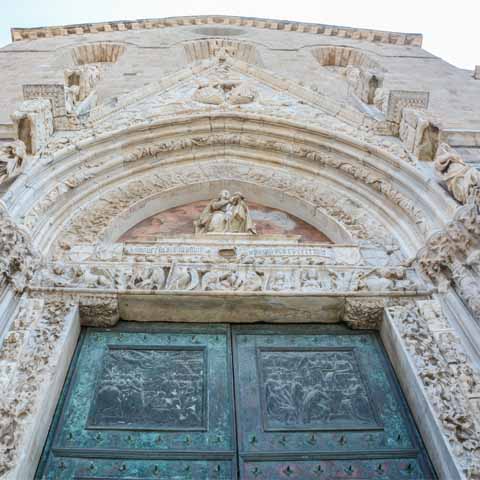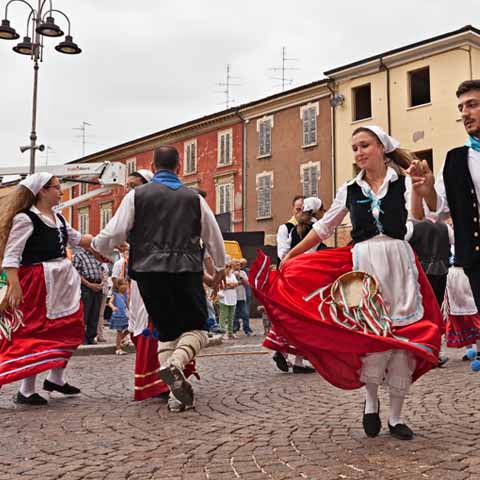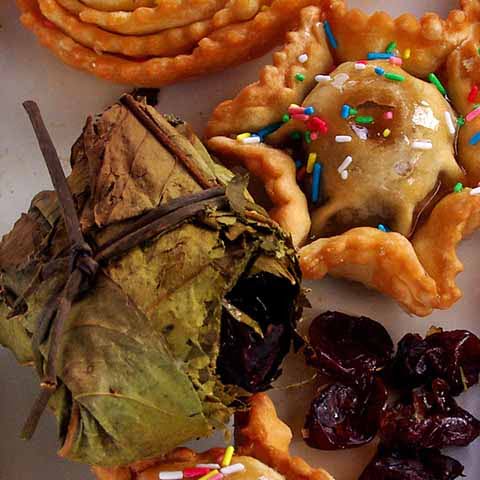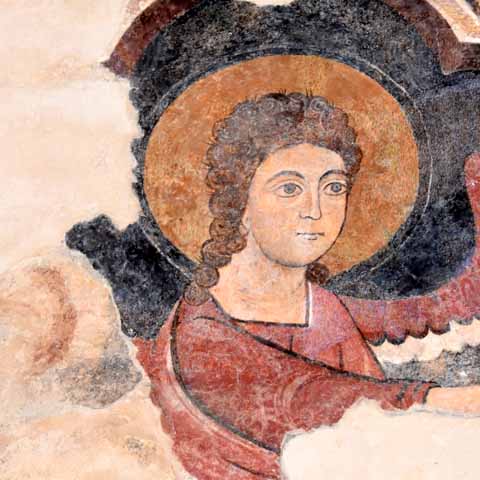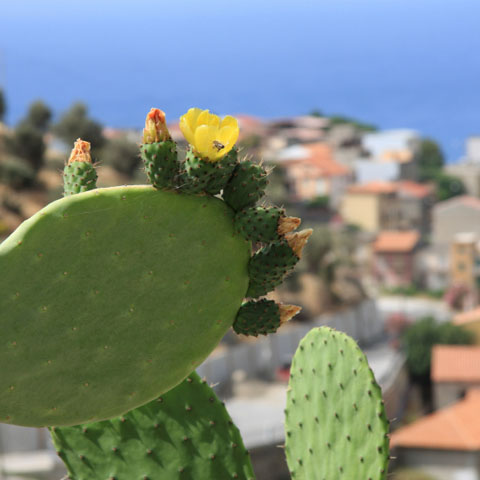A hub of activity on the Southern tip of Italy, the city of Reggio Calabria is a city of great culture. Both Italian and Greek influence can be seen in everything from architecture to cuisine. Whether you enjoy taking in the architecture of churches and open-air seaside theaters or the art and music sprinkled throughout the city, Reggio Calabria is a hidden treasure of Calabrian culture that is just waiting to be explored.
ARCHITECTURE
The Monument of Athena is a beautiful structure just off the shore of Reggio Calabria. The statue was built in honor of the Greek warrior goddess Athena who is thought to have defended the city against grave danger many times throughout the years. The monument is an icon of sorts for the city and stands tall on a pier stretching out from the promenade and into the waters of the Strait of Messina.
Just behind the Monument of Athena is a beautiful outdoor open air public amphitheater called Arena Dello Stretto or Arena of the Strait. The gorgeous white semicircular theater is built in a shape reminiscent of gym risers and is quite striking against the sparkling blue waters of the Strait. With such breathtaking views of the Strait and Sicily, the theater is still home today to important cultural events for the city, such as musicals and theater, as well as film and seasonal festivals.
The Reggio Calabria Cathedral, also referred to as Cattedrale di Maria Santissima Assunta in Cielo, is a beautifully ornate structure in the center of the city located in front of the Piazza Duomo. The church is thought to have origins tracing all the way back to Saint Paul who, in Acts 28:13 of the Bible, came to Reggio on one of his journeys. The church has sustained some damage over the years, and following the catastrophic 1908 earthquake, it was rebuilt in the Neoclassic style. The cream stone and marble exterior of the church features a wide stairway guarded by two statues, many arched and stained-glass windows, an intricate rose window, and four circular columns that stand the height of the building with a cross atop each.
The Forts of Pentimele, called Fortini di Pentimele by the locals, are old nineteenth century military fortifications that were originally built to protect the city. They sit upon the green Hill of Pentimele which offers stunning views of the city and the Strait of Messina and can be accessed by a rather narrow road. There is said to be a secret passage that at one time connected the forts to the port and the nearby Aragonese Castle.
The Villa Genoese Zerbi is an example of the area’s gothic architecture, although the building featured a far more Baroque style before being heavily damaged during the 1908 earthquake. For several years, the villa was a cultural center of Reggio Calabria and housed many artistic exhibitions including sculptures, paintings, and photography. The beautiful red and tan brick building features arched windows and a fascinating brick pattern that enhances the building’s exterior design. But perhaps the most interesting thing about this structure are the human form art exhibits that surround the building.
ART
One of the most unique and remarkable examples of art in Reggio Calabria can be found on the grounds of the Villa Genoese Zerbi. Several large contemporary statues that are works of art are located throughout the campus. They were created by artist Paola Epifani, also known as Rabarama, and are larger than life human forms whose “skin” is made of artistic patterns, letters, and symbols. Visitors often enjoy stopping here to have their pictures taken with these masterpieces.
Perhaps the most internationally famous art of Reggio Calabria are the Bronzi di Riace, or Riace Bronzes. These two legendary Greek bronze statues are thought to date back to fifth century BC. The statues were lost to the Ionian Sea for more than two thousand years before being discovered by a diver in the late twentieth century. These imposing figures stand more than six feet tall, are nude and very detailed. To view these magnificent works of art in person, plan a trip to the Museo Archeologico Nazionale di Reggio Calabria in Piazza de Nava. The museum itself hosts some of the most important artifacts from Magna Graecia and it is the most revered museum in Reggio Calabria.
For historic paintings, plan to visit the Pinacoteca Civica di Reggio Calabria, or the Civic Art Gallery. The bulk of the collection spans from the fifteenth century to the nineteenth century. Calabrian artists, such as Ignazio Lavagna Fieschi and Giuseppe Benassai, are represented here, as are other important Italian painters. Some of the most noteworthy works in the collection include two wooden tablets by Antonello da Messina, La battaglia di Capua by Andrea Cefaly and Il ritorno del figliol prodigo by Mattia Preti.
One of the most important cultural hubs in the area is the Pasquino Crupi Cultural Center. The permanent collection features works by renowned twentieth century artists, such as Giorgio De Chirico and Salvador Dalí. The center also hosts temporary exhibitions that are among the most significant in the region.
Art can take many forms, but for legendary and internationally renowned Italian designer Donatella Francesca Versace, it can be found in fashion. The designer was born in Reggio Calabria in the mid twentieth century and still today dresses some of the biggest celebrities in both American and Italian societies. She is the first woman to be named Designer of the Year for the 2018 GQ Men of the Year Awards in China and the United Kingdom.
LITERATURE
The Biblioteca Pietro de Nava, with roots in the early nineteenth century, is considered to be the oldest Calabrian library on record. The three-story structure was once known by the name of Regia Biblioteca Ferdinandiana, but was later changed to honor Pietro de Nava. The library is home to many literary works including historic parchment documents that date back as far as the late thirteenth century.
An important literary figure from Reggio Calabria is Domenico Spano Bolani. He authored a book specifically about Reggio’s ancient history. In addition to writing about history, Bolani was a participant in it by remaining active in local government as a member of Parliament and at one time a mayor. The first Reggio Calabria civic museum established in the early nineteenth century was named after him.
There were a number of ancient poets born near Reggio Calabria, such as Steischorus, Ibycus, and Nossis. The local literary movement in the Middle Ages was marked by scholar and theologian Barlaam of Calabria as well as Leonzio Pilato, who translated Homer, Euripides, and Aristotle. During the Renaissance, the writings of philosopher and theologian Tommaso Campanella, who was born in the province of Reggio Calabria, helped shape contemporary thought and ideals. Among all of these writers, however, perhaps the most influential local was Nicola Giunta. A pupil of Giosuè Carducci and Gabriele D’Annunzio, Giunta is best known for his poems written in the local dialect.
MUSIC
One of the more interesting musical connections to Reggio Calabria is the Museum of Musical Instruments, also known as MuStruMu. The museum has had a troubled history when in the early twenty-first century the building caught fire and much of the structure and instruments were destroyed. But with great perseverance, the building was slowly rebuilt and reopened. The museum typically displays a wide range of musical instruments from across the globe, with a special spotlight on traditional Calabrian instruments such as the chitarra battente.
The Teatro Comunale Francesco Cilea is a municipal theater that was originally built in the early nineteenth century but was relocated to the Palazzo San Giorgio after an earthquake in the early twentieth century. It was named in memory of famous Calabrian composer, Francesco Cilea. The theater has approximately fifteen hundred seats and is one of the largest theaters in the region of Calabria. The interior is a large semi-circle shape with several rows of balconies. Be sure not to miss the Civic Art Gallery of Reggio Calabria’s ancient paintings located on the first floor of the theater.
Francesco Cilea was a famous Italian composer of the nineteenth and twentieth century that was born just outside the city. Posthumously, Cilea is probably best known for his operas L’arlesiana and Ariana Lecouvreur. The Music Conservatory and Teatro Communale were both renamed in his memory for his amazing contributions to music.
Twentieth and twenty-first century lyric tenor Giuseppe Filianoti was born in Reggio Calabria. Throughout his career, Filianoti has toured and sung in opera houses across Europe and in New York. The critically acclaimed singer has won a variety of awards over the years for his contributions to the genre of opera and continues to sing.
Italian singers and sisters Mia Martini (Domenica Bertè) and Loredana Bertè were both born in the town of Bagnara Calabra in the province of Reggio Calabria. Both greatly impacted the evolution of Italian music, with Martini in particular recognized as one of the most influential Italian singers of all time.
CINEMA
The Reggio Calabria Film Fest usually takes place each March at the Francesco Cilea Theater in the city. The event celebrates Italian cinema of yesteryear and well as modern pictures. The Leopoldo Trieste Prize is usually awarded at this event to emerging stars of Italian cinema. The CortoReggio award is generally presented to outstanding short films.
Reggio Calabria and the surrounding province have also appeared on the big screen several times as the setting of Italian films, such as Un ragazzo di Calabria (1987), Corpo Celeste (2011), and Il sud è niente (2013).
SCIENCE
Nineteenth-century chemist Raffaele Piria was born in Scilla, which is now part of the metropolitan area of Reggio Calabria. Piria’s research contributed to the development of Aspirin, and he also discovered several important chemical reactions.
Journey to the toe of the boot of Italy and stay in Reggio Calabria to experience the outstanding beauty of both the land and the culture. This populous city seldom sleeps and is full of adventure and tradition. Come and be a part of the city’s modern-day story.
Don't just see Italy, live it.
Your dream trip to Italy has never been closer
No more endlessly scrolling travel sites. Our travel experts will craft the perfect, one-of-a-kind trip just for you.

300+
DESTINATIONS
We offer more Italian destinations than any travel site. Do and see more with Trips 2 Italy.
1 (of a kind)
ITINERARIES
Because your dream trip to Italy should be designed for you, not for the masses.
100%
PEACE OF MIND
From flights and accommodations, to food and activities - we take care of every detail.
